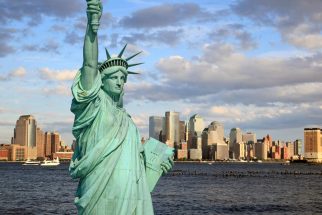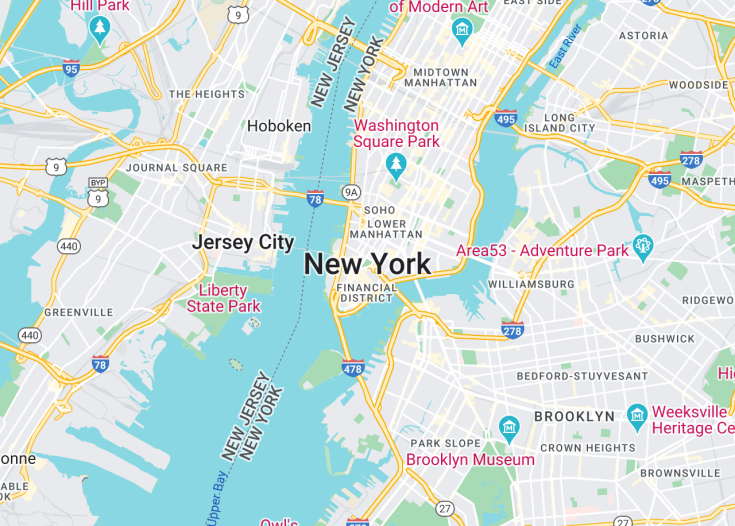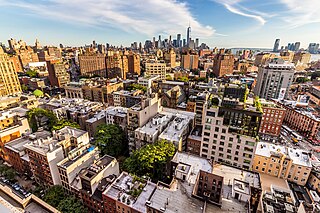Manhattan, the pulsating heart of New York City, is a dazzling metropolis filled with iconic landmarks, museums, and cultural richness that defines urban sophistication. From the towering skyscrapers of Midtown to the serene paths of Central Park, Manhattan offers a dynamic blend of historical grandeur and contemporary buzz. As a melting pot of arts, dining, and business, it stands as not only a powerhouse of the American economy but also a centerpiece of cultural diversity.
Consider purchasing a New York Pass for free access to over 100 attractions, including museums, tours, and landmarks, maximizing both savings and experiences.
Explore beyond the typical tourist paths by visiting neighborhoods like the Lower East Side or Greenwich Village to discover unique shops, local eateries, and vibrant street art.
Top things to do & see in Manhattan (New York City)
Select the following sights and activities to discover best tickets and tours available in Manhattan (New York City).
Manhattan (New York City): The Heartbeat of New York
| Country | USA |
| Time in Manhattan (New York City) | GMT-5 |
| Language spoken | English |
| Population | 1.6 million (According to the latest census data) |
| Currency | United States Dollar (USD $) |
| Airports |
|
Manhattan, one of New York City’s five boroughs, is a densely populated and iconic center of business, culture, and government. Known for its skyscrapers and historical significance, Manhattan plays a pivotal role in shaping global commerce, art, and trends. From the hustle and bustle of Wall Street’s stock exchanges to the artsy vibes of Greenwich Village, every street echoes a rich history that dates back to the earliest days of American colonization.
Where is Manhattan (New York City)?
Manhattan is situated on the mouth of the Hudson River in southeastern New York state.
Distances:
| Route | Distance by car | Time by car |
|---|---|---|
| Los Angeles to Manhattan | 2780 mi / 4474 km | 42 hrs |
What is Manhattan (New York City) famous for?
Manhattan is globally renowned for its role as a cultural, financial, and media powerhouse. It houses significant landmarks such as Times Square, Central Park, and Empire State Building that draw millions of tourists each year.
History
Before 1600: Native Roots
Before European arrival, the area now known as Manhattan was densely forested and inhabited by the Lenape people, a group of Native Americans utilizing the abundant rivers and fertile lands for fishing, hunting, and agriculture. The name “Manhattan” itself derives from the Munsee Lenape language term ‘Manna-hata,’ roughly translating to ‘island of many hills.’
1600s: European Settlement
The first significant European presence in Manhattan began with Henry Hudson, an explorer sailing for the Dutch East India Company, who arrived in 1609. His reports prompted the establishment of Dutch trading posts, with the southern tip of Manhattan, purchased in 1626 by Peter Minuit for trade goods worth 60 Dutch guilders, widely but incorrectly reported as worth about $24 in U.S. dollars. Thus began the European colonization, leading to the establishment of New Amsterdam, which later became a pivotal city in the new world.
1700s: Growth and British Rule
Throughout the 1700s, Manhattan came under British rule and transformed into a bustling port under the name New York. The city played a significant role during the American Revolution and was a focal point of several important developments and confrontations. Post-Revolution, the federal government chose the city as the first capital of the United States in 1789 with George Washington’s inauguration.
1800s: Industrial Expansion and Immigration
The 19th century was a period of rapid growth and industrialization for Manhattan. The opening of the Erie Canal in 1825 positioned the city as a vital gateway for trade and immigration to the interior of the continent. The influx of immigrants, particularly from Europe, dramatically changed the cultural landscape and drove a population boom that necessitated innovative solutions like the 1811 Commissioner’s Plan, which laid out the current grid system of streets.
1900s: Modern Metropolis
In the 20th century, Manhattan solidified its status as a global cultural and financial capital. Landmarks such as the Empire State Building and the Chrysler Building rose up during the skyscraper era of the 1920s and 1930s. Post-World War II, Manhattan became the headquarters for the United Nations, emphasizing its international influence. The latter half of the century saw economic fluctuations and recovery, highlighted by the development of complex financial services that powered Wall Street into a global financial center.
2000s-Present: Millennium New York
The devastating attacks of September 11, 2001, brought significant changes to Manhattan, with a focus on rebuilding and revival, culminating in the opening of the One World Trade Center in 2014. The city also continues to thrive as a center for media, technology, and education, constantly shaping its destiny while maintaining its standing as one of the world’s most iconic urban areas.
Visit Manhattan (New York City)
What to see and do in Manhattan (New York City), New York (USA).
Manhattan is brimming with iconic sights and cultural landmarks. Start your visit with a trip to Central Park, the heart and soul of New York City, which provides a green oasis amid the urban landscape. Visitors can explore renowned museums such as the Metropolitan Museum of Art and the Museum of Modern Art. No trip to Manhattan is complete without experiencing the bustling Times Square, the theater productions of Broadway, and the somber significance of the 9/11 Memorial & Museum. Additionally, take in panoramic city views from the observation decks of the Empire State Building or One World Trade Center.
- Central Park
- The Metropolitan Museum of Art
- Times Square
- Broadway Theater District
- 9/11 Memorial & Museum
- Empire State Building
Celebrating Manhattan’s Culture and Events
Manhattan is a hub of endless events and festivals throughout the year. Noteworthy occasions include the New York Fashion Week in February and September, the New York City Marathon in November, and the vibrant Macy’s Thanksgiving Day Parade. Seasonal activities also comprise summer concerts in Central Park and the Tribeca Film Festival in spring. Each event uniquely showcases the dynamic and diverse culture of New York City.
Best time to visit Manhattan (New York City)
Each season in Manhattan offers a unique charm, from the blooming landscapes of spring to the festive spirit of winter. However, for comfortable weather and fewer crowds, the best times to visit are during the spring (April to June) and fall (September to early November). These months provide pleasant temperatures and the opportunity to catch various city events.
Is Manhattan (New York City) worth visiting?
Manhattan stands as a beacon of cultural, financial, and architectural grandeur, making it an undeniable attraction for both domestic and international visitors. The city’s skyline, abundant in renowned monuments and museums, appeals broadly to those with an interest in history, art, and urban exploration. However, visitors should be prepared for the high cost of living and occasional overcrowding, particularly in tourist hotspots and during major events. Despite these challenges, the relentless vitality and diverse offerings make Manhattan a thrilling destination worth exploring.
What are some must-visit attractions in Manhattan?
- Statue of Liberty: A historic symbol of freedom, accessible by ferry.
- Central Park: A sprawling green oasis perfect for leisurely walks, boating, and ice skating in winters.
- Empire State Building: Offers breathtaking panoramic views of the city from its observation decks.
- Times Square: Known for its vibrant atmosphere, bright lights, and broadway theatres.
- Museum of Modern Art (MoMA): Hosts an extensive collection of modern and contemporary art.
- Metropolitan Museum of Art: One of the world’s largest and finest art museums.
- 9/11 Memorial & Museum: Pays tribute to the lives lost in the September 11, 2001 terrorist attacks.
- High Line: An elevated linear park built on a historic freight rail line.
These attractions offer a blend of history, culture, and modernity, each providing a unique perspective of Manhattan.
What are the best dining experiences in Manhattan?
- Le Bernardin: Known for its exquisite French seafood and elegant ambiance.
- Katz’s Delicatessen: Famous for its classic New York pastrami sandwiches.
- Eleven Madison Park: Offers a fine dining experience with a focus on modern gastronomy.
- Street Food Vendors: Don’t miss out on the street food scene offering everything from hot dogs to international cuisines.
- Chinatown: Dive into authentic Chinese dim sum and noodles.
- Little Italy: Enjoy traditional Italian dishes and pastries.
Exploring Manhattan’s culinary offerings provides a delightful journey through local and international flavors.
What are the best shopping districts in Manhattan?
- Fifth Avenue: Home to high-end boutiques and large department stores like Bergdorf Goodman and the Apple flagship store.
- SoHo: Features trendy boutiques, upscale chains, and artistic outlets.
- Chelsea Market: Offers a mix of food vendors, artisan shops, and unique boutiques.
- Madison Avenue: Known for designer labels, high fashion, and luxury goods.
Each shopping district in Manhattan offers its own charm and selection of goods, making it a must-visit for shopaholics.
Where can I find the best views of Manhattan?
- Top of the Rock Observation Deck: Offers unobstructed 360-degree views from the Rockefeller Center.
- One World Observatory: Located on the top floors of the One World Trade Center, providing panoramic views.
- Brooklyn Heights Promenade: Great for views of the Manhattan skyline, particularly beautiful during sunset.
- Edge at Hudson Yards: The highest outdoor sky deck in the Western Hemisphere with a glass floor.
These viewpoints provide stunning perspectives of Manhattan, suitable for breathtaking photography and memorable visits.
What cultural activities can I engage in while in Manhattan?
- Broadway Shows: Catch a world-famous theater production in the Broadway district.
- Metropolitan Opera: Experience high-quality opera performances.
- Jazz Clubs: Visit historic venues like the Blue Note or Village Vanguard for exceptional jazz music.
- Art Galleries: Explore contemporary art at galleries in Chelsea or the Lower East Side.
- Public Readings: Attend a reading at the Strand Bookstore or the New York Public Library.
These activities highlight Manhattan’s rich arts scene and provide deep cultural immersion for visitors.
Where can I experience nature in Manhattan?
- Central Park: Central Park provides walking trails, rowboat rentals, and open meadows for picnics.
- Riverside Park: Located along the Hudson River, ideal for biking and jogging with scenic water views.
- Bryant Park: Hosts seasonal gardens and free outdoor movies during the summer months.
- Battery Park: Offers a serene setting and waterfront promenade with views of the Statue of Liberty.
Each location offers a touch of nature and a pleasant break from the city’s bustling pace.
What architectural landmarks should I visit in Manhattan?
- Empire State Building: An Art Deco masterpiece and iconic New York City skyscraper.
- Flatiron Building: Known for its unique triangular shape and historical significance.
- The Guggenheim Museum: Features a unique spiral design by Frank Lloyd Wright.
- Chrysler Building: Displays a striking Art Deco style, notable for its terraced crown.
- St. Patrick’s Cathedral: A Neo-Gothic structure unlike any other in the city.
Each of these architectural landmarks tells a story and represents an era of architectural innovation in Manhattan.
What non-touristy things can I do in Manhattan?
- Walk the East River Promenade: Enjoy a quieter walk with views of Brooklyn and Queens.
- Visit Local Farmer’s Markets: Explore markets like Union Square Greenmarket for fresh produce and local goods.
- Attend a live podcast recording: Check out live recordings of popular podcasts at venues like The Bell House.
- Explore the bookshops: Spend time in local bookshops such as McNally Jackson or Books Are Magic.
- Experience the Speakeasy Bars: Discover hidden bars across the city for a unique nightlife experience.
These activities provide a glimpse into the everyday life of Manhattan residents and offer a different perspective on the city.

















